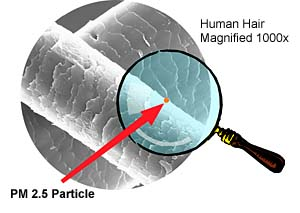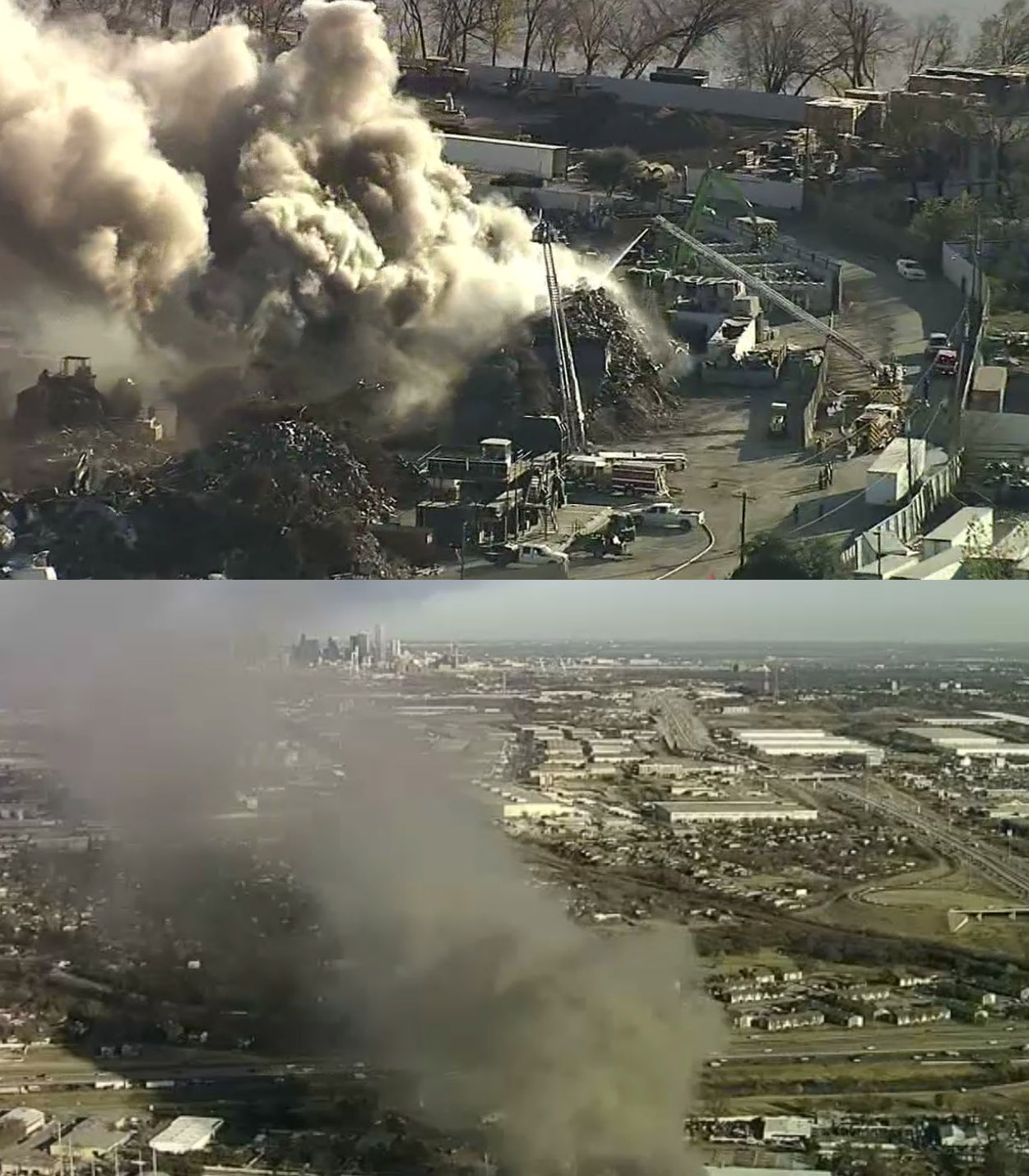Toxicology
James McGuire has Left the Building, But Will Dallas’ City Hall Continue to Neglect Environmental Health and Justice Remain?

Friday was reportedly James McGuire’s last day as Dallas’ Director of the Office of Environmental Quality and Sustainability. He’s said to be taking leave for the rest of July and then he’ll move on…to a position at the Trump EPA. After serving for sometime as an “Interim Director,” he’d been the real thing for the last three years.
McGuire’s departure comes almost a month before the unveiling of the implementation schedule of his crowning achievement, Dallas’ Climate Plan, in front of the City Council. Speculation about his leaving ranges from this being a done deal triggered by the Climate Plan’s passage in May, to being fallout from the City being included as a defendant in Marsha Jackson’s Shingle Mountain lawsuit two weeks ago.
During his tenure McGuire, a City attorney who got assigned the OEQS position, earned kudos for policies that directly affected internal City operations – where and how the City bought electricity for it’s facilities, or how efficiently city operations saved water.
But almost every time he stepped outside of City Hall into public policy his record has been a disaster, especially for Southern Dallas.
Time and again, when McGuire had the chance to help Southern Dallas residents, he turned his back, or worse, contributed to the problem they were complaining about. A short list of his “greatest misses” includes:

- Promotion of Batch Plants in Southern Dallas. In 2018 and 2019 four separate batch plants were trying to win permission from the city to locate in already overburdened Joppa and Flora Farms (Shingle Mountain). McGuireand OEQS endorsed all of them. But much worse was McGuire’s purposely misleading statements about current air quality in Joppa during the Council’s debate on the permits. Asked if current Particulate Matter pollutant levels in Joppa should be of any concern, McGuire disingenuously said EPA monitors “in Dallas” showed levels “meeting national standards.” It wasn’t until a pointed follow–up question from a Council Member reveled the cynicism of his answer: the nearest (and only) EPA PM monitor was nine miles away, on the other side of downtown. Residents defeated all four batch plant permits despite OEQS’s endorsement.
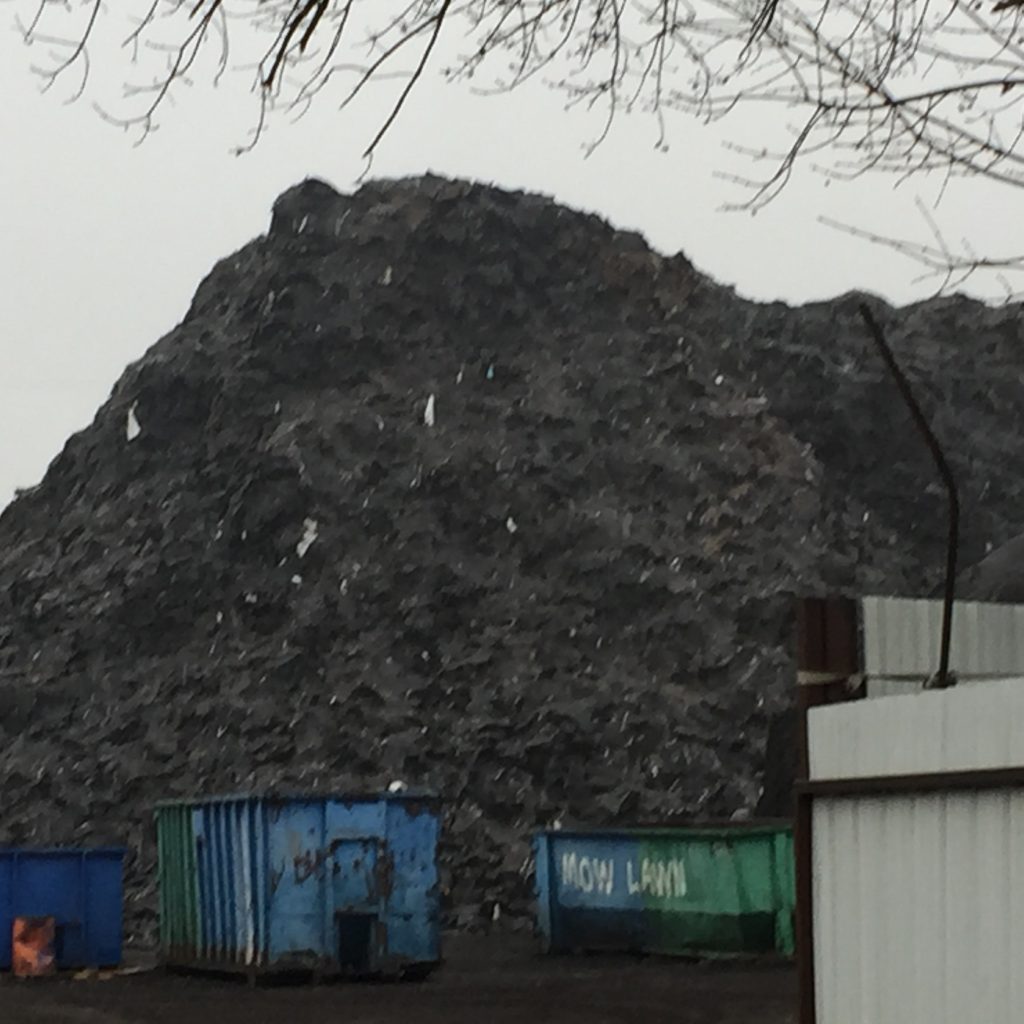
- Creation of Shingle Mountain. The six story 100,000 ton illegal dump – Dallas’ largest and most dangerous – was over a year and a half old and was violating a multitude of laws and regulations with impunity when McQuire first learned about it from DMN columnist Robert Wilonsky. The most notorious environmental justice disaster in Dallas in 25 years happened on his watch without him or anyone in his department noticing. Compounding this mistake – which nobody has every apologized for – was the OEQS’ absolute obsession with storm water non-compliance issues at the dump to the exclusion of any concern for adjacent residents’ health from fumes or particulate matter containing carcinogens. At no point over the last two years has McQuire or OEQS said anything about how toxic the dump is to human health, but he and the Department have been very, very concerned about illegal storm water runoff.
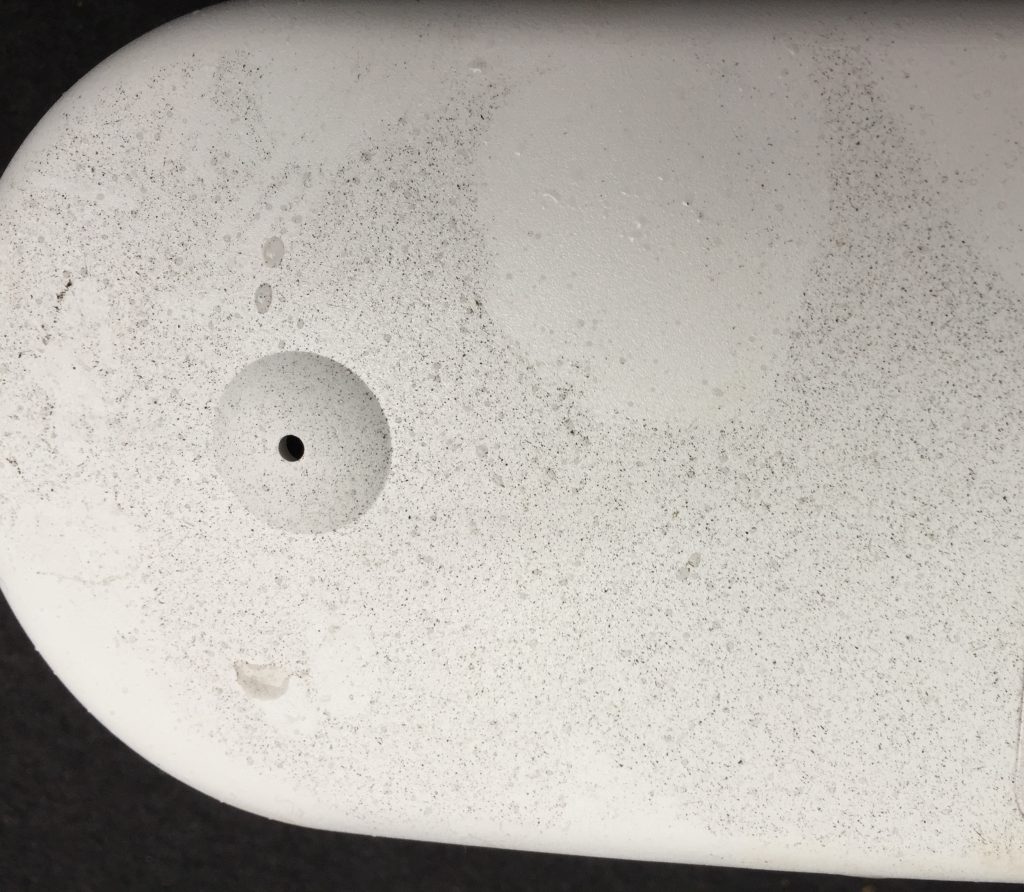
- Denying pleas for air quality monitoring from residents of Joppa and Shingle Mountain. In 2018 OEQS representatives rejected Joppa residents’ request that the City provide air quality monitoring – even after portable monitor readings by Downwinders found high levels of PM pollution there, and even though the City had the monitoring equipment to do so. McGuire and OEQS also tuned down Marsha Jackson’s pleas to do air monitoring at her house under the six-story Shingle Mountain illegal dump, even though Downwinders’ portable monitors placed on her windowsill were completely covered in a black dust and recorded hazardous levels of PM pollution.
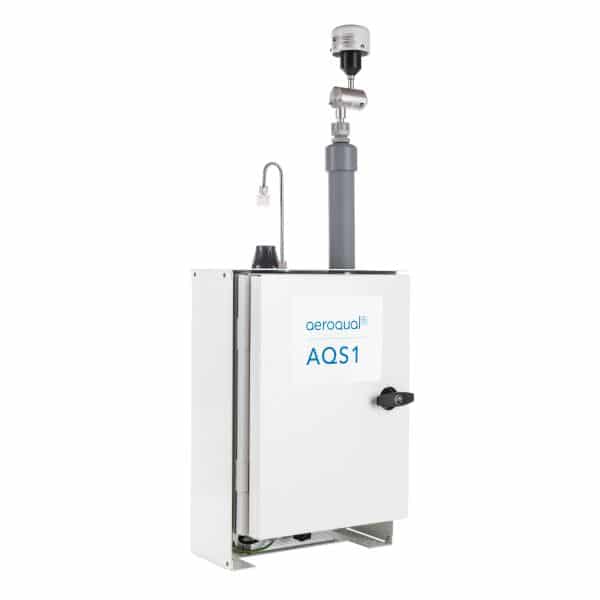
- The collapse of the City’s “Breathe Easy” air monitoring initiative. After planning for years to deploy 10 to 12 air monitors at public schools in Dallas, the City finally identified the schools it wanted to participate, bought a dozen new Aeroqual air quality monitors, and then informed DISD of its intent. DISD said no thanks; they didn’t want the monitors on school property. The 12 brand new monitors are sitting in a closet somewhere unused. And by the way, no one would know about this epic fail if Downwinders hadn’t fought tooth and nail through the Texas Open Records Act to get the documentation. DISD’s rejection was already a done deal when OEQS staff gave a briefing to City Council on the project…but neglected to mention that the school district had rejected the idea. Some folks would call that a cover-up.

- Withdrawing from the SharedAirDFW Community Air Monitoring Network. Before he began the City’s own Breathe Easy project, McGuire and Dallas was part of group working to build a regional air monitoring network that included Plano, Dallas County, Dallas County College, Paul Quinn College, and area school districts among others. After participating in the Network for a year, he and the City abruptly withdrew their support when a proposed governing structure for the Network required citizen participation. All the other entities stuck around ,and the first SharedAirDFW monitors are about to go online in the next 30-45 days. Meanwhile the rival Breathe Easy effort McGuire invented to avoid public participation went bust. He single handedly set the City of Dallas back years on this front.

- Using a “compliance is protection” defense to avoid talking about environmental health issues. There’s now a decade of scientific evidence that connects exposure to levels of pollution far below the “national standard” set by EPA to serious health injury, including early death. But McGuire and OEQS never acknowledged this evidence. Not once. Instead, as long as the one (!) PM monitor in Dallas showed levels that were within the obsolete 24 hour or yearly standard enforced by EPA, the conclusion was always that “Dallas was in compliance.” But science says compliance isn’t protection. Houston’s environmental department employs a toxicologist who goes to Black and Brown neighborhoods where batch plants are being proposed and tells residents there’s no safe level of exposure to PM pollution. Dallas had a lawyer who stayed in his office, spoke of “compliance,” and approved them.
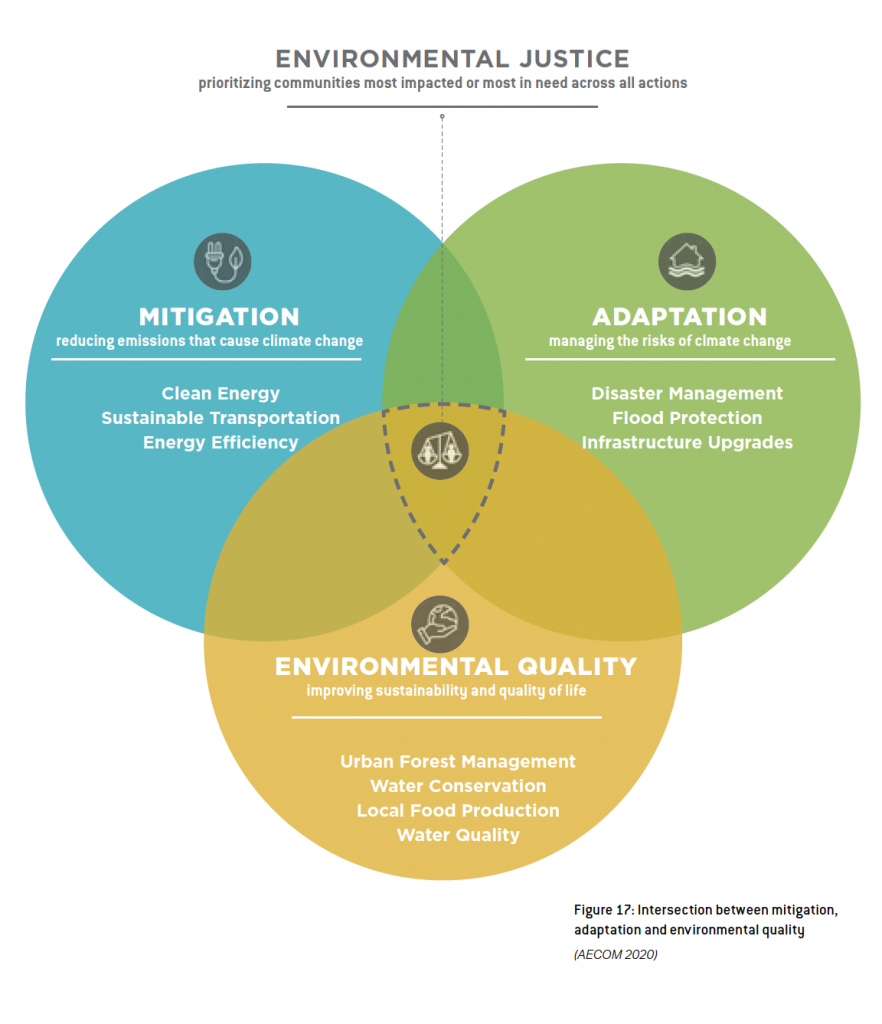
- Using race-neutral language to to discuss racist environmental justice issues. Although the OEQS probably used the word “equity” more than any other city department in its presentations, it refused to acknowledge that racist redlining, zoning, and decision-making underlies much of Southern Dallas’ pollution problems. Instead, it used all kinds of euphemisms for “racist” to describe the predicament of Joppa and Shingle Mountain residents. When the City’s Climate Plan came to dealing with environmental justice, it threw away the original race-based definition by Dr. Robert Bullard, the guy who invented the phrase, and adopted a consultant’s definition that ignored any mention of race. Nobody but Southern Dallas residents noticed. Oh yeah, it also mentioned water conservation, but not clean air.
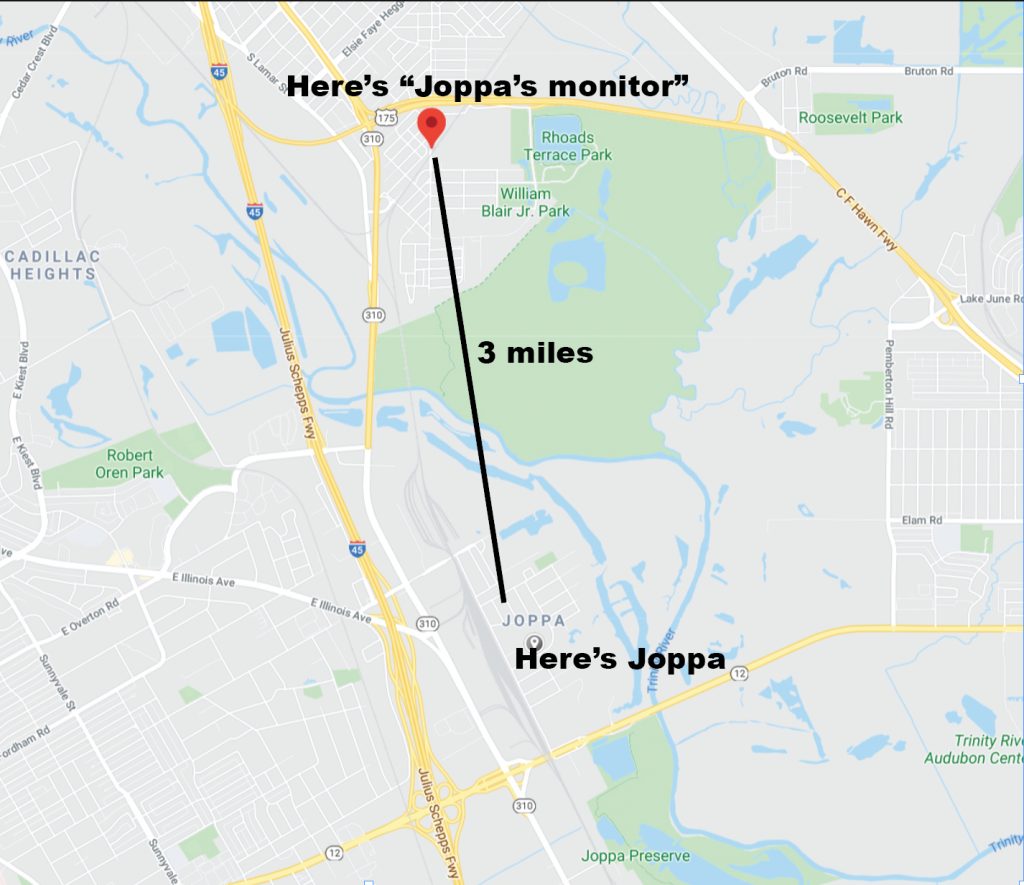
- One of his final acts as OEQS Director was also one of McGuire’s most cynical, which is saying a lot. In June he and his staff hailed the official announcement of the City’s deployment of a single PM monitor “in Joppa” when in fact the monitor is located three miles north of the former Freedman’s town in the entirely separate neighborhood of Bonton. In one of the most up-is-down moments of McQuire’s administration, OEQS staff actually told their audience of impressed Council Members that a monitor located three miles away from the closest source of Joppa industrial pollution would be better able to capture that pollution than it would across the street in Joppa itself. They presented no evidence to prove that absurd claim, most likely because it runs contrary to the last quarter century of actual science. But that evidence was ignored to try to make the City look like it was doing something it was not.
With a record like that you wonder how the guy kept his job as long as he did until you realize almost all of his sins were committed against Southern Dallas and People of Color. When it came to things like the City’s feeble Climate Plan that North Dallas white environmentalist were craving, he was an ally. But none of those folks lived in neighborhoods with a batch plant or a illegal dump. Their support came cheap and was completely disconnected from reality on the ground in Southern Dallas.
In choosing McGuire’s replacement there’s a chance to change the way the City of Dallas looks at environmental issues. Fundamental to this change must be inclusion of “environmental health” as a primary focus. The goal must not be just to comply, but to protect.
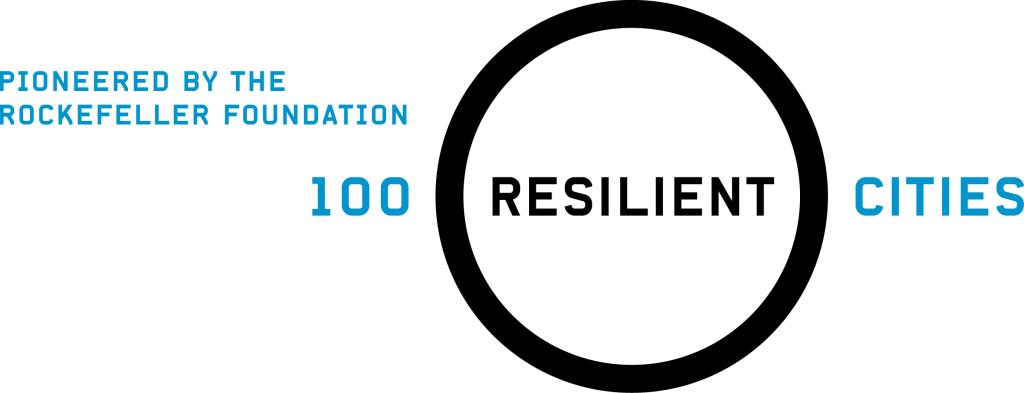
For the past five years or so “resilence” and “sustainability” have been the hot code words for action surrounding green issues. Fueling this semantic change was the Rockefeller Foundation, that for awhile was giving huge grants to every city that would commit itself to a resilency planning. Dallas chased and got that money and so has a “Resilency Plan” that you’ve probably never seen, out of which sprang the City’s Climate Plan. But that Rockefeller money has stopped flowing and so “resilency” is suddenly getting a lot less play.
Now it’s “sustainability.” Still chasing grant dollars, the City practically tripped over itself in swiftly changing the name of the “Office of Environmental Quality” to the “Office of Environmental Quality AND Sustainability” and created a while new Council “Committee on the Environment AND Sustainability.”
But more often than not “Sustainability” doesn’t include environmental health. Sustainability is water conservation, or tree cover, or renewable energy. It isn’t fighting batch plants, racist zoning, or reducing the health damage caused by pollution meeting the national standard by way of a monitor on the other side of town. “Sustainability” is a word that takes the emphasis away from the goal of better human health and puts it on abstract policy goals. That makes it a red flag for People of Color whose health suffers disproportionately from pollution. It signals yet another detour away from addressing their daily poisoning.
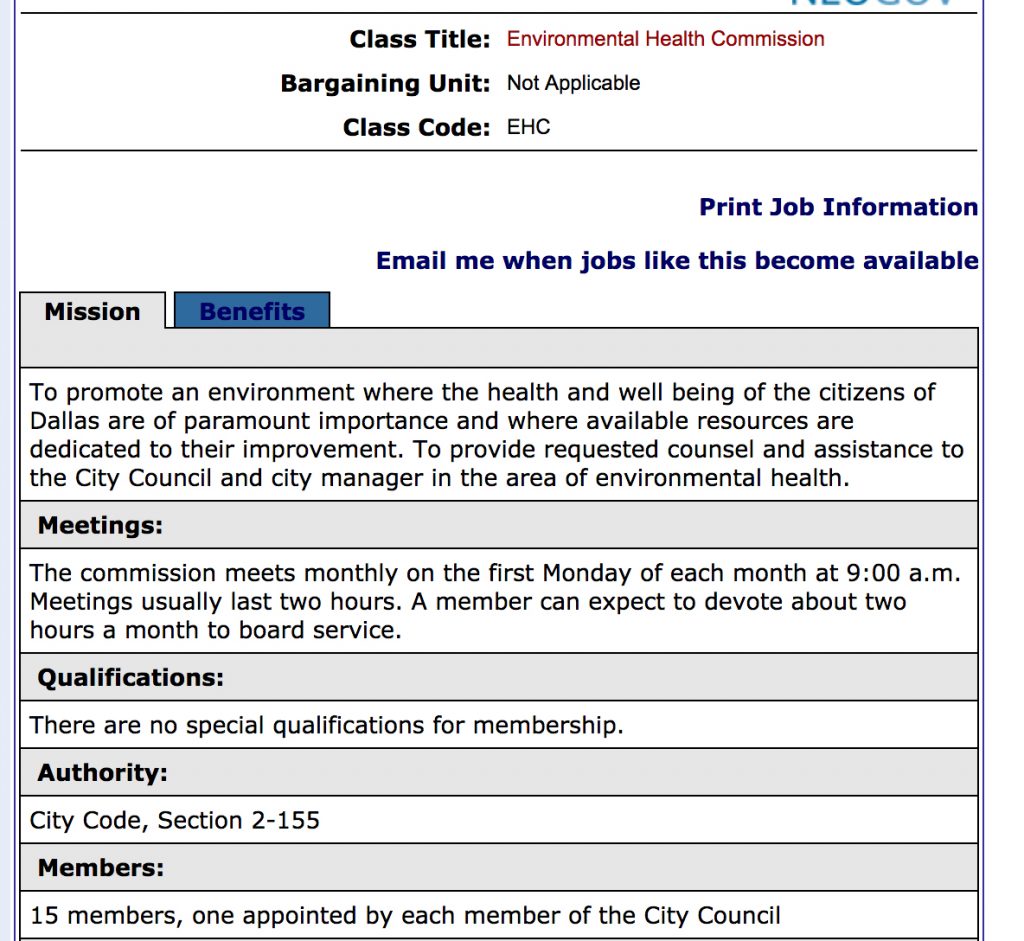
That’s why Downwinders and Southern Sector Rising fought for inclusion of the words “environmental health” in the City’s Climate Plan back in May. But not even a single Dallas City Council Member would agree to include it. So they’ll be yet another City Committee formed to address “sustainability” but not one that has environmental health in its mission.
Now City Hall has a chance to send a message that they’re listening; to make a break with the status quo that produced that long and undistinguished record above. The new OEQS Director could be a turning point…or just another brick in the wall.
Downwinders is advocating McGuire’s replacement should be at least two things: 1) a Person of Color, and, 2) a scientist, preferably a toxicologist, epidemiologist, or public health specialist. No more lawyers.
OEQS needs a fresh new face. One that isn’t already weighted down by City Hall baggage. Black and Brown scientists are likely more qualified to address environmental health injustices in Dallas due to their perspective on race and the environment, and therefore should be proactively recruited for the job” Their perspective is desperately needed at Dallas City Hall.
But a new bio at the top won’t do Southern Dallas much good unless the mission of the OEQS changes as well.
Before McGuire, it was commonplace for environmental health issues to be addressed by the City – either through the former Environmental Health Commission or campaigns like the one then Mayor Laura Miller mounted against a wave of new coal plants being pushed by Rick Perry. McQuire’s neglect of environmental health is the anomaly here, not the other way around.

That kind of pro-active approach needs to be restored, if only to head-off problems before they become lawsuits. The new OEQS Director should feel free to speak about what the science says, and fully embrace public health considerations, not dodge them.
Given the context of the last two months of national uprisings, the situation on the ground and in the courts at Shingle Mountain, plus the rapidly advancing public dialogue on all things Race, the OEQS needs to come to terms with its role as a public health arbiter for Southern Dallas. It would be great if this next Director saw their job as working to reduce environmental health damage there instead of trying to cover it up.
Environmental Organizing on Giving Day 2020

TUESDAY GIVING DAY UPDATE:
We’re over half-way to our goal of $10,000.
Please help us get there today.
1. Today the Communities Foundation of Texas is sponsoring a special COVID crisis North Texas Giving Day for DFW non-profits.
2. The Peace Development Fund has chosen to spotlight the COVID-connected work of Downwinders and 12 other groups across the country to help during the crisis.
The Fund and generous donors are matching every dollar we raise this week up to $10,000 – that’s a $20,00,000 grant on the line.
We have until Friday to raise the $10,000.
You can help us reach this goal right now by contributing at our North Texas Giving Day Page or the Mighty Cause pay portal the Development Fund has set up for us.
Thanks for your support,


Evelyn Mayo, Chair
____________________________________
COVID Connects:
Community Organizing to
Environmental Health
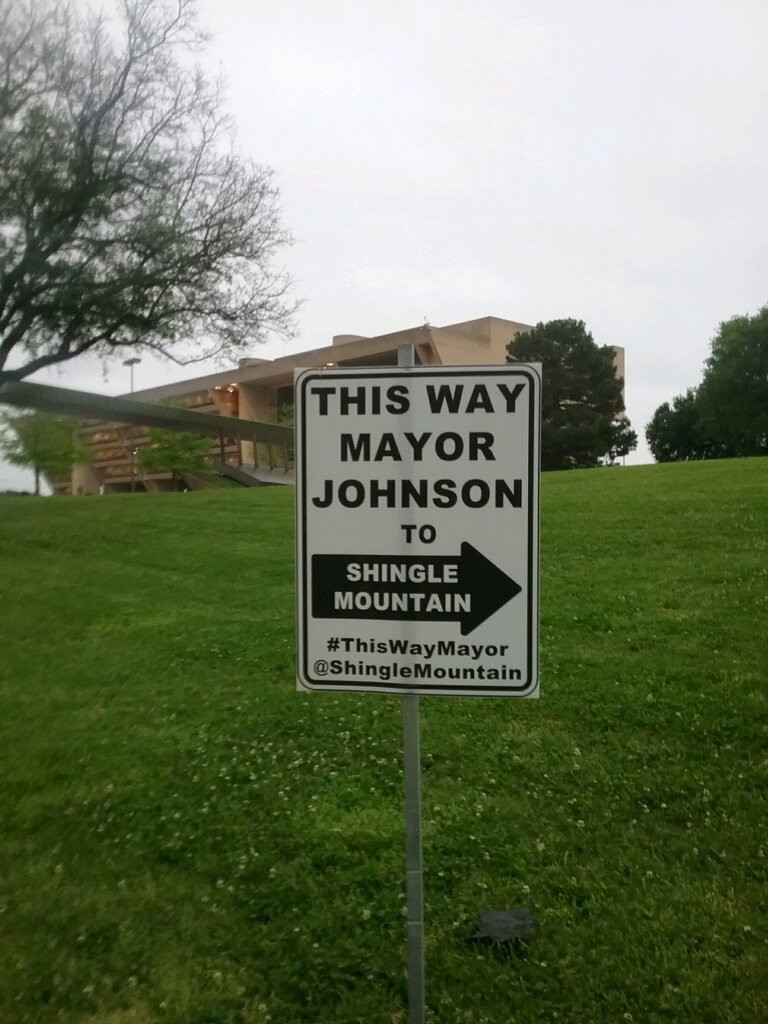 200 signs like these went up across Dallas on Earth Day 2020. Major Johnson has yet to visit or speak publicly about the highest profile environmental justice scandal since the West Dallas RSR lead smelter Superfund site 25 years ago.
200 signs like these went up across Dallas on Earth Day 2020. Major Johnson has yet to visit or speak publicly about the highest profile environmental justice scandal since the West Dallas RSR lead smelter Superfund site 25 years ago.
What is It?
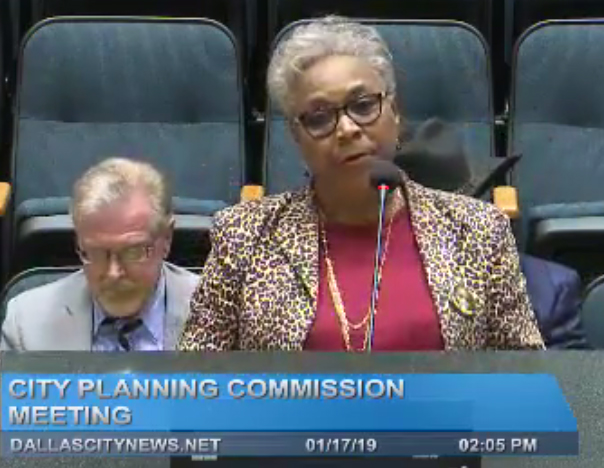 Downwinders provides much needed basic organizing resources to local grassroots environmental health fights.We offer the only full time staff devoted to applying community organizing principles to assist groups. We provide start-up funding for fliers and other materials. We’re the only citizens group that has the technology to take air pollution samples…and the classes to teach you how to do it as well. Mostly, we give those in need the attention they’re not getting from officials or anyone else.
Downwinders provides much needed basic organizing resources to local grassroots environmental health fights.We offer the only full time staff devoted to applying community organizing principles to assist groups. We provide start-up funding for fliers and other materials. We’re the only citizens group that has the technology to take air pollution samples…and the classes to teach you how to do it as well. Mostly, we give those in need the attention they’re not getting from officials or anyone else.
Most importantly, we show how to use a fight to change the system that produced the problem. The most recent example is the Shingle Mountain illegal dump and the group Southern Sector Rising that was created to shut it down and clean it up.
Why Do It?
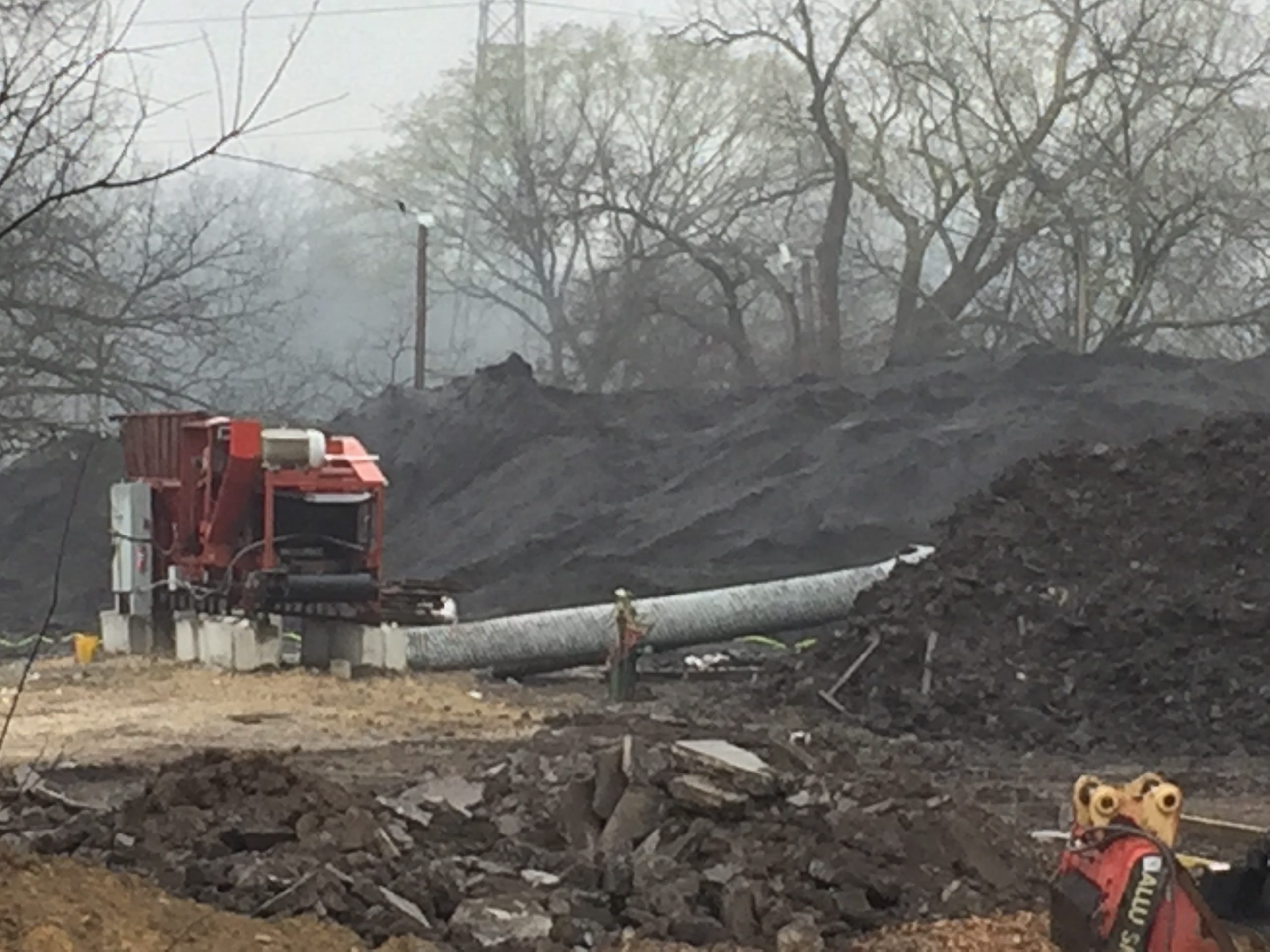 Shingle Mountain for almost a year when she finally found Downwinders. It took us only three months of organizing with Ms. Jackson to get the City to reverse itself and file suit against the site’s operators to close the site.Out of that effort sprang Southern Sector Rising, a group aimed at not only seeking justice for Shingle Mountain residents but making sure Dallas implemented a citywide Environmental Justice agenda. Part of that agenda, announced on March 20th 2019 at a City Hall news conference, was the restoration of the Dallas Environmental Health Commission and a Environmental Equity Provision that would steer polluters away from already over-polluted neighborhoods.
Shingle Mountain for almost a year when she finally found Downwinders. It took us only three months of organizing with Ms. Jackson to get the City to reverse itself and file suit against the site’s operators to close the site.Out of that effort sprang Southern Sector Rising, a group aimed at not only seeking justice for Shingle Mountain residents but making sure Dallas implemented a citywide Environmental Justice agenda. Part of that agenda, announced on March 20th 2019 at a City Hall news conference, was the restoration of the Dallas Environmental Health Commission and a Environmental Equity Provision that would steer polluters away from already over-polluted neighborhoods.
Southern Sector Rising and Downwinders are using the example of Shingle Mountain to pass policies aimed at preventing new Shingle Mountains.
What’s the COVID Connection?
In 2020 it seems obvious that municipal governments need to address environmental health issues. But Dallas ditched it’s original Environmental Health Commission a decade ago.
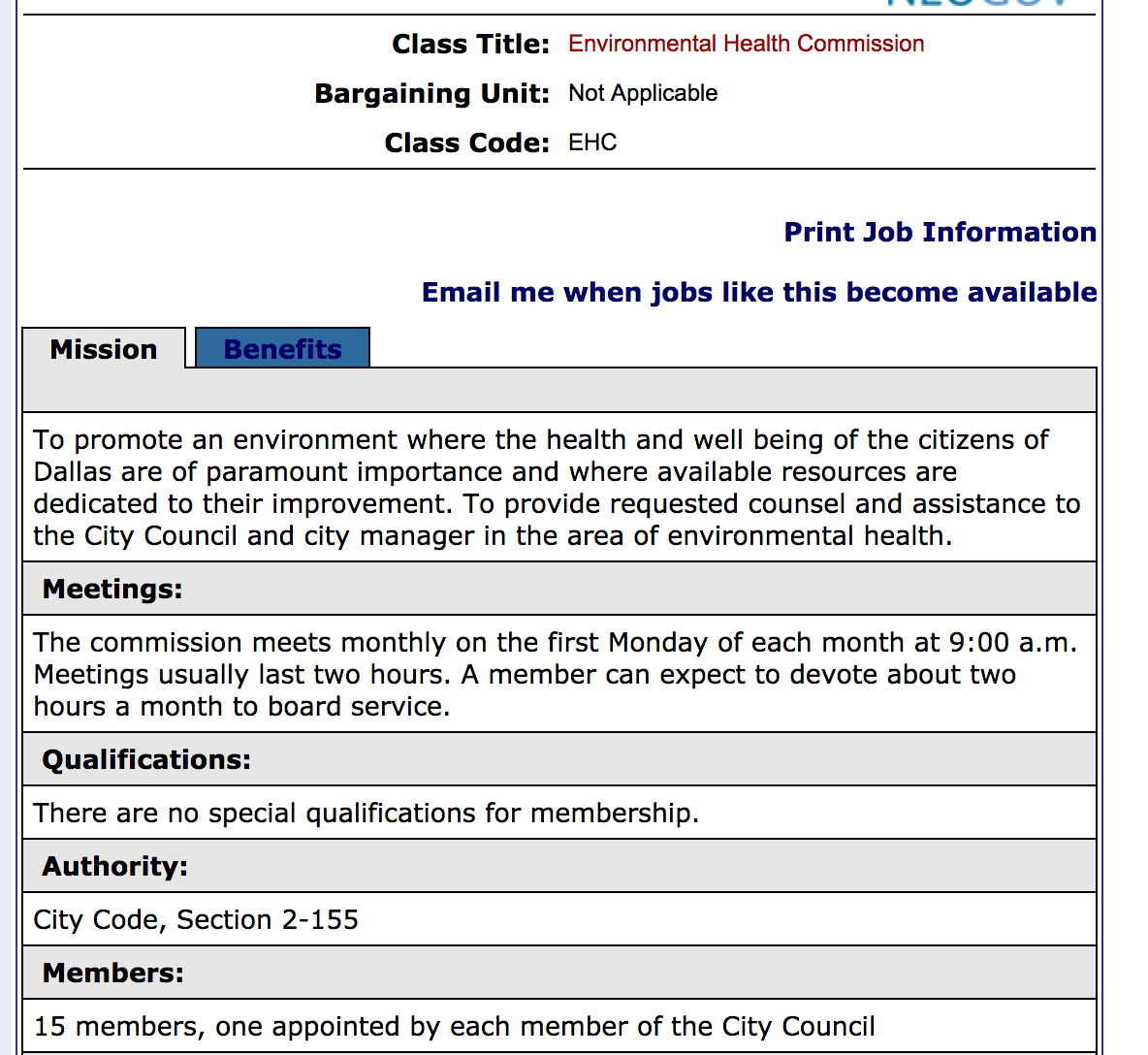 Formed in the wake of the 1980’s West Dallas and East Oak Cliff Lead smelter fights, the Health Commission was a citizen-based watchdog. It recommended the effective banning of hazardous and medical waste incineration in the City and wrote a tough anti-smoking policy before the Council disbanded it.
Formed in the wake of the 1980’s West Dallas and East Oak Cliff Lead smelter fights, the Health Commission was a citizen-based watchdog. It recommended the effective banning of hazardous and medical waste incineration in the City and wrote a tough anti-smoking policy before the Council disbanded it.
Had the Commission been around in 2017, it’s likely the Shingle Mountain dump would have shown-up on Dallas City Hall’s radar screens a lot sooner than it did when a reporter had to tell officials about the outrage a year later.
And an “equitable” economic development policy would end the practice of illegal dumpers and grifters targeting Southern Dallas for their schemes. That pattern of “development” is one reason why residents find themselves more vulnerable to COVID.
Before the virus, City Hall policy avoided environmental health issues. This pandemic shows why it must embrace and plan for them.
STATUS?
Southern Sector Rising has asked that restoration of the Dallas Environmental Health Commission be part of the City’s new climate plan, up for a vote on May 27th. Despite 10 of the current 15 Dallas City Council members having endorsed the idea only last Spring, there’s been no public movement toward adoption. 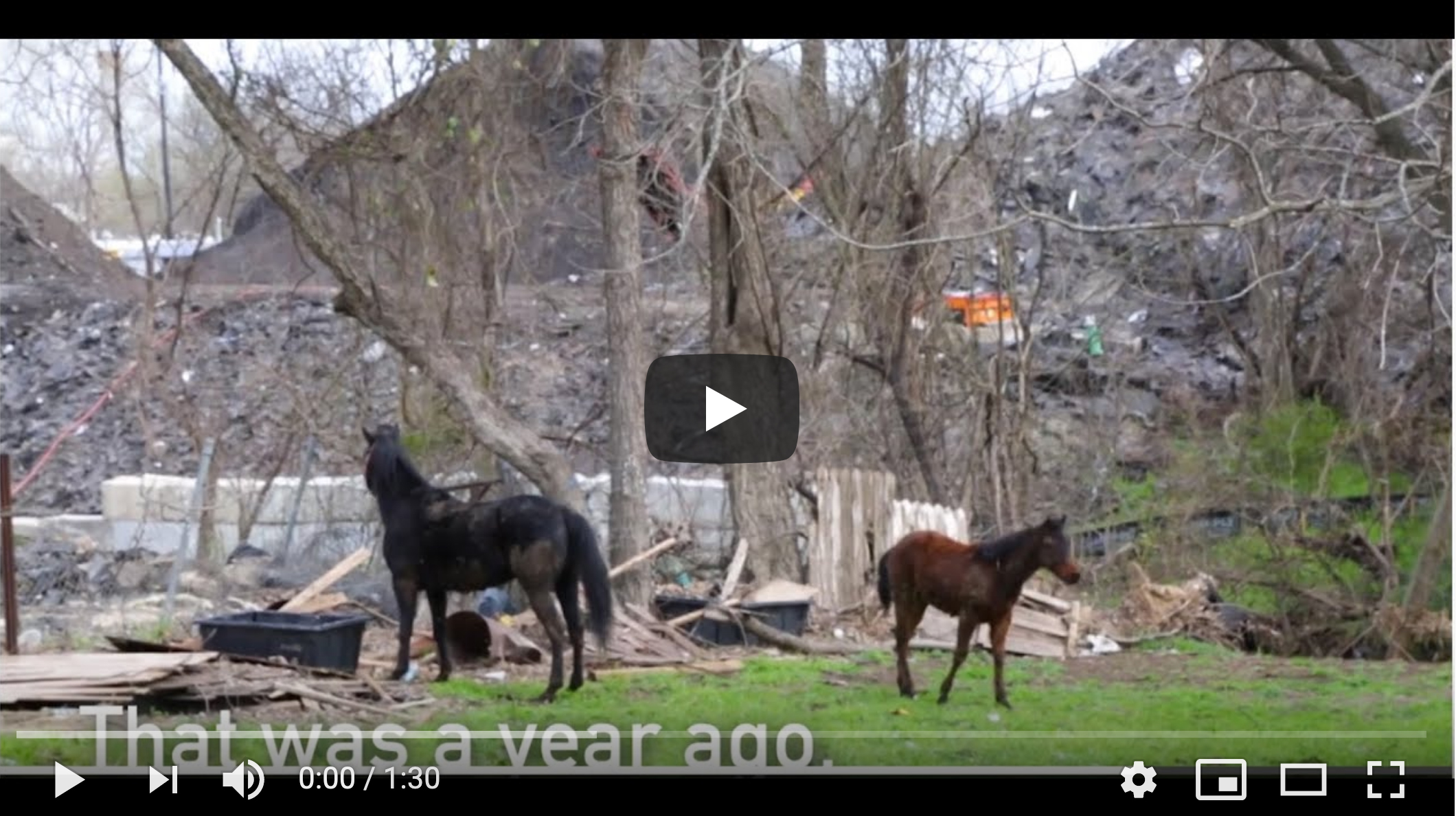
SSR won the closing of Shingle Mountain as an active operation, but the dump itself remains an on-going public health crisis in its own right. Over 100,000 tons of petroleum based asphalt shingles
are stacked 6-7 stories high next door to Dallas residents, including families with children.
Despite being invited and holding office for a year, Dallas Mayor Eric Johnson has never visited or commented publicly on Shingle Mountain.
over 200 “directional aids” went up around
ACTION YOU CAN TAKE:
Here’s a link to a quick “ClickNSend” letter you can send Dallas Mayor Eric Johnson to help him find his way to Shingle Mountain
COVID CONNECTIONS
Downwinders At Risk was already dedicated to fighting for environmental health in North Texas before the COVID virus hit.
Focusing on harmful Particulate Matter, we were already supporting grassroots efforts to reduce the air pollution burdens in predominantly Black and Brown neighborhoods.
We were already building out local capacity to monitor DFW air pollution and advocating an increased role for local cities and counties to protect their residents from environmental health threats.
All of that work was important before March. It’s become more important since then. But our responsibilities on the ground are outstripping our ability to support them adequately. Like other non-profits, the virus has made it harder to do even the simple things.
This week you can help provide some relief.
The Peace Development Fund has chosen to spotlight the COVID-connected work Downwinders is doing, along with that of 12 other grassroots groups across the country to help supplement their budgets during the crisis. The Fund and generous donors are matching every dollar we raise this week up to $10,000 – that’s a $20,00,000 grant on the line.
We have until Friday to raise the $10,000.
Beginning today and continuing thru Tuesday the 5th at Midnight you can help us meet this goal by contributing via our North Texas Giving Day Page.
Then Wednesday thru Friday the Development Fund has its own Downwinders Mighty Cause pay portal you can also use.
We’re using each day this week to show how our various pieces of program work is more relevant than ever before. Today it’s an update on our ambitious new DFW air monitoring network – SHAREDAIRSDFW.
We know everyone is having a hard time, but with the Development Fund matching your dollars, you can make whatever contribution you give go twice as far to benefit those at highest risk.
Thanks for your support,


Evelyn Mayo, Chair
COVID Connects:
Vulnerable Communities to the Need
for Better Air Pollution Monitoring
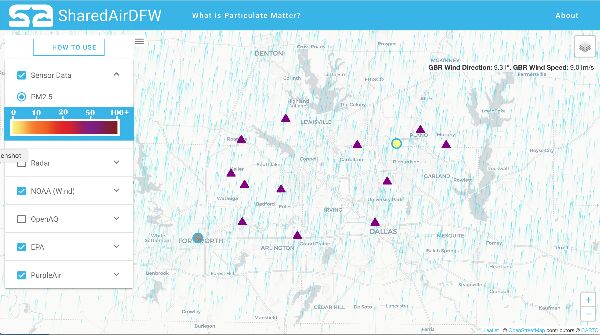
A screenshot of the SHAREDAIRDFW network map being assembled by UTD students and Downwinders at Risk. This map will soon be available at websites hosted by UTD, Dallas County and Downwinders, Only two of the over 100 new monitors are installed (dots) but more are on their way.
What is It?
The SHAREDAIRDFW community air quality monitoring network.  With its partners at UTD, Downwinders is building a new air monitoring network for DFW that will provide real time information from over 100 locations, including industrial hot spots in Joppa, West Dallas and Midlothian.
With its partners at UTD, Downwinders is building a new air monitoring network for DFW that will provide real time information from over 100 locations, including industrial hot spots in Joppa, West Dallas and Midlothian.
Why Do It?
Dallas County’s 2.7 million residents currently share only one EPA 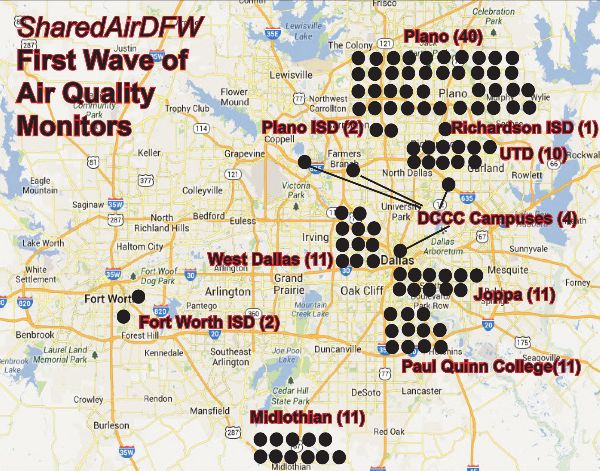 Particulate Matter air pollution monitor, north of downtown. Tarrant County has two and Denton County one. These monitors only reflect very local conditions and don’t reveal pollution levels in “frontline” neighborhoods where industry operates next to homes.
Particulate Matter air pollution monitor, north of downtown. Tarrant County has two and Denton County one. These monitors only reflect very local conditions and don’t reveal pollution levels in “frontline” neighborhoods where industry operates next to homes.
Making pollution burdens more equitable across racial and class lines requires identifying, measuring, and mapping those burdens: “You can’t fix what you don’t measure.” The SHAREDAIRDFW network is the first attempt to permanently map air pollution burdens across North Texas and make that information easily accessible to the public 24/7.Dallas County’s 2.7 million residents currently share only one EPA Particulate Matter air pollution monitor, north of downtown. Tarrant County has two and Denton County one. These monitors only reflect very local conditions and don’t reveal pollution levels in “frontline” neighborhoods where industry operates next to homes.
Making pollution burdens more equitable across racial and class lines requires identifying, measuring, and mapping those burdens: “You can’t fix what you don’t measure.” The SHAREDAIRDFW network is the first attempt to permanently map air pollution burdens across North Texas and make that information easily accessible to the public 24/7.
What’s the COVID Connection?
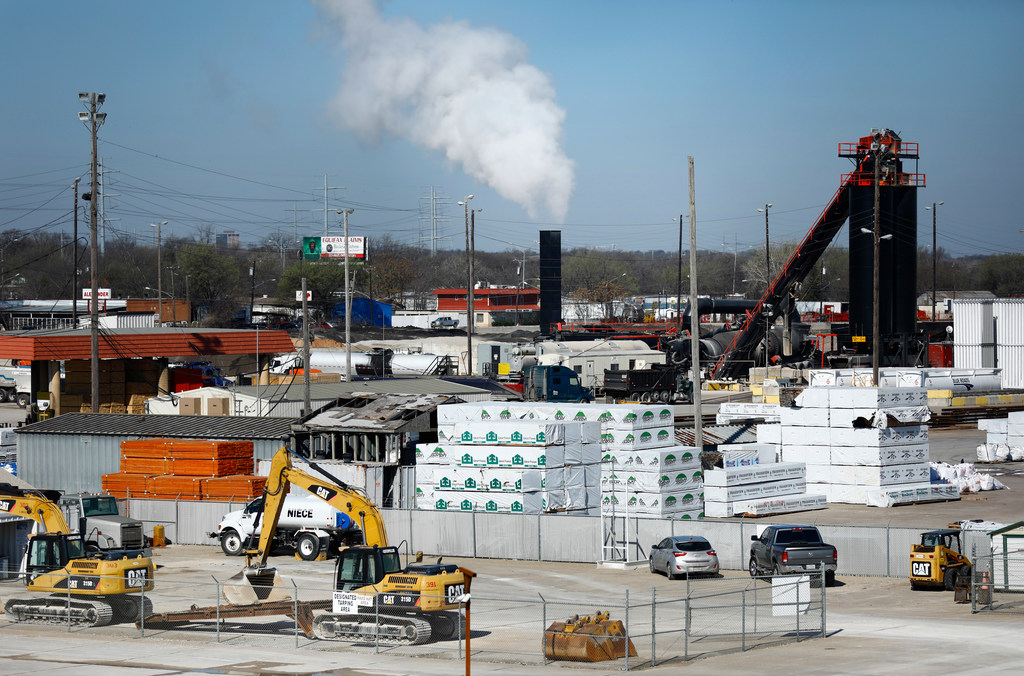
Research being done during the COVID pandemic concludes those living with the highest air pollution burdens are among the most vulnerable to being infected and dying from it. Specifically there seems to be a connection between a person’s exposure to Particulate Matter and Nitrogen Oxide air pollutants and the likelihood of contracting COVID. Past studies from the SARS epidemic also point to a strong link between exposure to air pollution and vulnerability to illness.By mapping where the heaviest air pollution burdens are, we can avoid adding to that burden and pursue policies targeting pollution decreases. We can begin to reverse the circumstances that makes the most pollution-impacted neighborhoods the most vulnerable to disease.
STATUS?
Via teleconferencing, UTD students are finishing up the digital map the Network 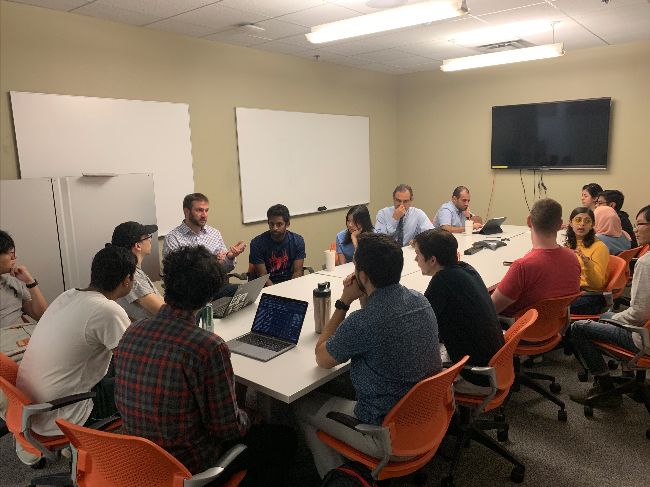 will use to display its real time air quality information. This map is meant to display not only the levels recorded by our own fleet of monitors, but easy access to the handful of EPA and Purple Air monitors in DFW as well.
will use to display its real time air quality information. This map is meant to display not only the levels recorded by our own fleet of monitors, but easy access to the handful of EPA and Purple Air monitors in DFW as well.
The map will be hosted on websites hosted by UTD, Dallas County and Downwinders.The first community monitors are slated for the former Freedman’s town of Joppa, where Downwinders bought a utility pole for the installation of the larger Mothership monitor. We’ve got a contract for Internet service and are now trying to tie down electrical power.
After a planned community meeting in March was canceled, we’re now gearing back up to find hosts for all ten “satellite” monitors. We hope to be able to begin operat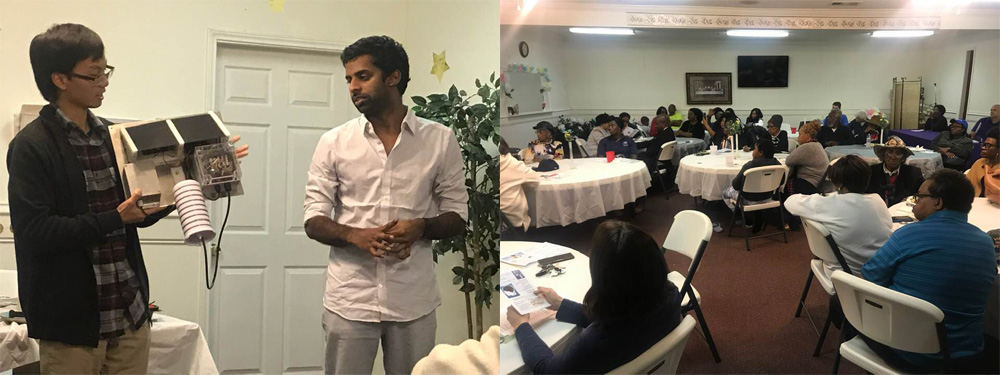 ion this summer.Once we’re up and running in Joppa, West Dallas is next and then Midlothian. In all Downwiwnders will be responsible for 33 of the over 100
ion this summer.Once we’re up and running in Joppa, West Dallas is next and then Midlothian. In all Downwiwnders will be responsible for 33 of the over 100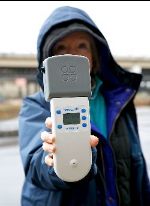 network monitors going up as part of the first wave installation.
network monitors going up as part of the first wave installation.
……MEANWHILE, Downwinders is using its portable monitors to record air quality in front line neighborhoods during the shelter-in-place periods so we’ll have a baseline for what cleaner air looks like.
Texas Misusing 17-Year Old Rural Air Pollution Model to Permit Inner-City Joppa Asphalt Plant
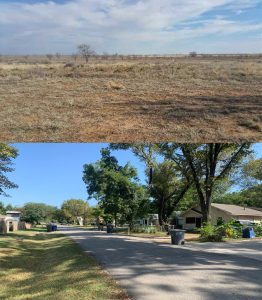
One of these is not like the other
What if you found out an industrial polluter was operating in your densely-populated neighborhood and the state told you not to worry because an obsolete computer model of the polluter’s releases 17 years ago and 500 miles away, in a desert, performed by the polluter themselves, said everything was OK?
That’s exactly the situation Joppa residents find themselves in as the Texas Commission on Environmental Quality (TCEQ) goes through the motions of renewing one of the permits of the many industrial polluters located in the community.
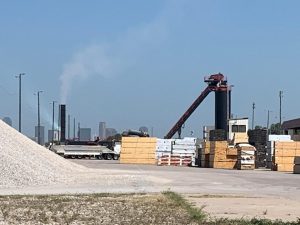 Austin Industries’ asphalt batch plant sits next to the Marietta Martin (TXI) concrete batch plant in Joppa, and both are in the Union Pacific switch yard and all of those are adjacent to the giant Tamko asphalt roofing factory.
Austin Industries’ asphalt batch plant sits next to the Marietta Martin (TXI) concrete batch plant in Joppa, and both are in the Union Pacific switch yard and all of those are adjacent to the giant Tamko asphalt roofing factory.
Austin has applied to the TCEQ for a renewal of its 10-year old air permit for its Joppa plant and gave notice last December. Legal Aid of NorthWest Texas requested a contested case hearing on behalf of the Joppa Freedman’s Town Association and Downwinders at Risk requested one on behalf of resident Jabrille McDuffie.
To absolutely no one’s surprise, TCEQ’s Executive Director recommended against such a hearing at the beginning of August in comments mailed out to all parities. He argued that contrary to the opponent’s claims there was sufficient evidence that Austin Industries permit in Joppa was following the law and was “protective of human health.” Previous “air quality analysis,” the Executive Director says, have concluded such already.
The entire basis of that “air quality analysis” is the computer air modeling performed by Austin Industries’ hired contractors and supposedly double-checked by the state…in 2002.
Just like any other computer model, it all depends on the variables: volume of air pollution, local meteorology, stack height, local “receptors” aka people or animals who live by or near the facility, and even local terrain. Winds do one thing to air pollution on the open plains and another in the middle of a city block.
Because of these variables, an Exxon refinery that wants to build a facility in Houston with the exact same design as is has in Arkansas still has to submit a separate computer model to account for the distinct surroundings in the new location. The one from Arkansas just won’t do for Houston.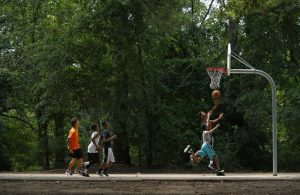
Or at least that’s the way things are supposed to work. But like so much else in Southern Dallas these days, things aren’t working the way they’re supposed to.
According to the TCEQ the Austin Asphalt facility is a portable asphalt batch plant operation. That means it wasn’t built specifically for its current Joppa site. It was moved there and it can be moved somewhere else.
In 2002 it first operated in Hockley County, a rural part of Northwest Texas near Lubbock some 400 miles west of Joppa. It moved to its current location in Joppa in 2008.
In 2002 the TCEQ let Austin Industries use what’s called a “SCREEN3” air model to determine if the air pollution from its asphalt batch plant’s was a threat to anyone in Hockley County. Again unsurprisingly, the firm hired by Austin Industries to do the computer modeling found it was “protective of human health.”
TCEQ says the Austin Industries’ asphalt plant has never been subject to any additional “impacts evaluation.” besides this 2002 review.
That means the only air modeling ever done for this Austin asphalt plant was while it was operating in rural Hockley County in 2002. There has been no air modeling of the plant since it came to Joppa in 2008.
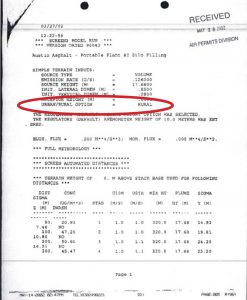
In 2002 the Austin plant was in West Texas and used a rural air model. In 2019 they’re still using for it for operation in Joppa.
Besides the most obvious and important difference in population density between unincorporated Hockley County near Lubbock and inner city Dallas, all of the variables in the 2002 modeling apply only to the Hockley County location. Meteorology, stack height, and surrounding terrain among them. In fact, the entire model was defaulted to a “rural” versus “urban” option in 2002. This renders the modeling scientifically useless in its current location in Joppa.
But that uselessness isn’t keeping the Executive Director of the Texas Commission on Environmental Quality from citing it to justify renewal of Austin’s air permit.
There’s also the matter of the age and limitations of the SCREEN3 model. In 2011 EPA replaced it with something called the “AERSCREEN” model. In doing so the agency called the old model “outdated“ and said “there are no valid reasons” to keep using SCREEN3.
And it’s not just the EPA. State environmental agencies, like the Arizona Department of Environmental Quality, have quit accepting SCREEN3 modeling.
Alex De Visscher, Associate Professor and Canada Research Chair in Air Quality and Pollution Control Engineering at the University of Calgary, writing in an 2013 text book entitled “Air Dispersion Modeling: Foundations and Applications,” said SCEEN3 is a “product of a previous generation of air dispersion modeling” and “is no longer a recommended model… it does not allow for multiple sources, and it does not include atmospheric chemistry or deposition.”
These exclusions are important. There are multiple sources of Particulate Matter 2.5 air pollution at Austin Industries’ plant in its Joppa location, including piles of raw material, and industrial combustion at the site. SCREEN 3 modeling didn’t and wouldn’t reflect these multiple sources of pollution. And of course when you’re talking about PM 2.5 pollution, as you are with an asphalt batch plant, the atmospheric chemistry and deposition, or fallout, is critical.
TCEQ’s own air modeling guidelines say so:
“Air dispersion models utilize dispersion coefficients to determine the rate of dispersion for a plume. Dispersion coefficients are influenced by factors such as land-use / land-cover (LULC), terrain, averaging period, and meteorological conditions. Evaluating the LULC within the modeling domain is an integral component to air dispersion modeling. The data obtained from a LULC analysis can be used to determine representative dispersion coefficients. The selection of representative dispersion coefficients may be as simple as selecting between rural or urban land-use types. For the ISC, ISC-PRIME, and SCREEN3 models, the dispersion coefficients are based on whether the area is predominately rural or urban. The classification of the land use in the vicinity of sources of air pollution is needed because dispersion rates differ between rural and urban areas.”
The TCEQ itself says it makes a fundamental difference whether the air model for a polluter is run for urban or rural terrain. Yet for over a decade TCEQ and Austin Asphalt have misused the results of a “rural” computer model to misleadingly assure inner-city Joppa residents that the company’s asphalt plant posed no harm.
What’s more, the modeling performed in 2002 only examined “asphalt vapors,” a made-up, vague pollutant category that can’t be monitored or measured. It didn’t examine Particulate Matter 2.5 pollution or specific Volatile Organic Compounds that make up those “vapors” and was therefore incomplete in the extreme.
So despite all the verbage the TCEQ’s Executive Director uses to tell Joppa residents th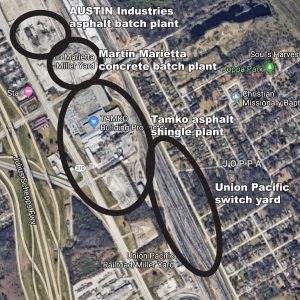 at past “air analysis” has shown Austin Industries’ plant to be protective of human health, in truth the only “analysis” ever done was performed 17 years ago in a sparsely-populated rural location 400 miles away from its current location, with what TCEQ admits are totally inaccurate modeling inputs by company consultants. It didn’t include all priority pollutants or even all sources of air pollution from the facility and the model used is now considered obsolete by EPA, modeling experts, and other state environmental agencies.
at past “air analysis” has shown Austin Industries’ plant to be protective of human health, in truth the only “analysis” ever done was performed 17 years ago in a sparsely-populated rural location 400 miles away from its current location, with what TCEQ admits are totally inaccurate modeling inputs by company consultants. It didn’t include all priority pollutants or even all sources of air pollution from the facility and the model used is now considered obsolete by EPA, modeling experts, and other state environmental agencies.
Joppa residents deserve better.
In its response to the Executive Director, Downwinders at Risk specifically requested TCEQ delay further regulatory action on this permit renewal until it can conduct a modern comprehensive air modeling impact analysis for Austin Asphalt’s current operation in Joppa that requires an evaluation of all on-site sources of pollution, including fugitive and mobile sources, on the Austin Asphalt site, off-site near-by sources of pollution within a three kilometer (1.86 mile) radius of Austin Asphalt’s facility, and representative monitored background concentrations obtained from local Joppa neighborhood monitoring as well as modeling of permitted maximums emission rates form all sources.
On September 11th the Texas Commission on Environmental Quality will take up the Austin Industries permit renewal at its headquarters in Austin. Both Legal Aid and Downwinders at Risk representatives will be present to answer any questions from the Commissioners but will not be allowed to make any statements. We’ll let you know the outcome.
One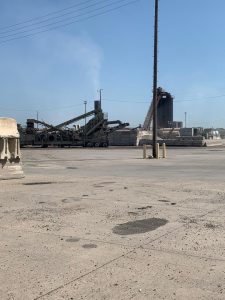 might reasonably ask why the City of Dallas itself isn’t fighting this permit renewal? After all in 2007, the city took on a string of proposed coal-fired power plants that it said would increase air pollution for Dallas. But to date that same city has never bothered to try and stop an industrial polluter from opening shop or renewing its permit in one of its most abused neighborhoods.
might reasonably ask why the City of Dallas itself isn’t fighting this permit renewal? After all in 2007, the city took on a string of proposed coal-fired power plants that it said would increase air pollution for Dallas. But to date that same city has never bothered to try and stop an industrial polluter from opening shop or renewing its permit in one of its most abused neighborhoods.
This dishonest use of a irrelevant model by the state’s discredited environmental agency shows why it’s imperative the City of Dallas – and all municipalities in Texas – change the way they do business and be proactive in addressing their environmental justice and environmental health issues in their own city limits.
Too often city representatives default to state or federal officials on the environment when they should be the first line of defense, not the last. City officials’ reliance on a failed state agency to perform its job as environmental protector is what caused Shingle Mountain. It’s what caused this situation in Joppa. To change that means changing both policies coming out of City Hall and current City Hall culture. Environmental Protection is a Do-It-Yourself proposition these days.
A New Round of PM Studies
Rising air pollution linked with increased ER visits for breathing problems
Air pollution could be as bad for pregnant women as smoking
Racial disparities in asthma related to health care access, environmental factors
High PM exposure nearly doubles dementia risk in older women
Air pollution is greatest environmental threat to global health in 2019, according to the World Health Organization
New Study Finds PM in Placentas

Scientists already knew that maternal exposure to PM pollution had the potential to harm fetal development. Studies have documented higher rates of Autism, ADHD and other developmental diseases in close proximity of freeways and other large sources of PM pollution. But until now researches hadn’t actually identified how PM harmed newborns.
According to a study presented last week at the European Respiratory Society’s (ERS) international congress in Paris, researchers have found the first evidence that particles of air pollution travel through pregnant women’s lungs and lodge directly in their placentas.
Using an optical microscope, they examined the placentas of five non-smoking women who all delivered healthy babies. They found 72 dark particles among 3,500 cells and then used a powerful electron microscope to examine the shape of some of the particles. They looked like the sooty particles found in macrophages in the lung.
One of the study’s authors, Dr Lisa Miyashita of Queen Mary University of London, ruled out almost any other substance, “We can’t think of anything else they could be. It is very evident to us they are black sooty particles.” Dr Norrice Liu, also at Queen Mary University of London and part of the team stated, “We also know that the particles do not need to get into the baby’s body to have an adverse effect, because if they have an effect on the placenta, this will have a direct impact on the foetus.”
Almost every effort examining the health effects from PM pollution over the last decade have all concluded there’s no level of exposure that’s not capable of leaving some harm behind. What this new study indicates is that many of us may already be harmed by exposure even before we’re born and that may make additional exposure that much more harmful.
Just this past month two new reports were published that linked PM pollution to significant IQ loss and diabetes.
In separate research, also presented at the Paris congress, researchers found that children with early onset and persistent asthma fared far less well in education than those without the condition.
The study, conducted over 20 years in Sweden, showed that children with asthma were three and half times more likely to leave school at the age of 16 with only basic education and were also twice as likely to drop out of university courses
New Study Links PM Pollution to IQ Loss
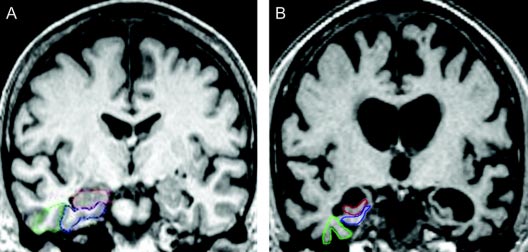
Underscoring how important this month’s event are is a new study from China that concludes exposure to Particulate Matter air pollution erodes a person’s IQ, especially in older people.
“Polluted air can cause everyone to reduce their level of education by one year, which is huge,” said Xi Chen at Yale School of Public Health in the US, a member of the research team. “But we know the effect is worse for the elderly, especially those over 64, and for men, and for those with low education. If we calculate [the loss] for those, it may be a few years of education.”
In some ways this latest research, published in Proceedings of the National Academy of Sciences (PNAS), only confirms earlier studies associating PM pollution with Dementia and other developmental diseases like Autism and ADHD. But it was the largest study yet to look at the impact PM has on cognitive abilities and it looked at people of all ages, not just students. 20,000 men and women were followed for four years and many other variables besides exposure to air pollution were ruled out as causes of the decline, including the inevitable decline of mental dexterity with age.
The more a person was exposed to dirty air, the more their intelligence suffered, with language skills suffering more than mathematical or analytical, and men more than women.
At the same time even short term exposure to air pollution was seen to have an effect on intelligence, a result with consequences for students taking tests or workers attempting to passing certification exams.
Derrick Ho from Hong Kong Polytechnic University was quoted in a Guardian article stating his own research group had similar preliminary findings in their work. “It’s because high air pollution can potentially be associated with oxidative stress, neuroinflammation, and neurodegeneration of humans.”
Specifically, exposures to pollutants such as carbon monoxide (CO) and particulate matter prevent proper blood flow and could affect the flow of oxygen to the brain, which in time, affect cognition. Long-term exposure of these pollutants can lead to lesions in the brain’s white matter, which is dangerous for cognitive skills.
The study has worrying implications for neighborhoods like Joppa and West Dallas that are crowded next to PM polluting industries and freeways. Residents from those communities often start out with material or social disadvantages that limit their opportunities. Constant exposure to a toxin that robs them of IQ points makes things even worse. It’s one more thing that can trap them in downward spiral.
On Eve of Council Vote, First-Ever Monitoring Finds PM Levels Already Too High in Joppa
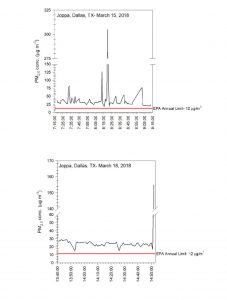 Downwinders PM Committee did the unthinkable this last week and monitored ambient air quality in the tiny Joppa community, where two proposed new concrete batch plants coming up for a Dallas City Council vote on Wednesday want to set-up shop.
Downwinders PM Committee did the unthinkable this last week and monitored ambient air quality in the tiny Joppa community, where two proposed new concrete batch plants coming up for a Dallas City Council vote on Wednesday want to set-up shop.
This was unthinkable because despite months of controversy over the siting of yet more concrete batch plants in a predominantly-minority neighborhood already jammed with heavy industry nobody had thought of doing it before our team of SWAT Citizen Scientists showed-up.
Not the batch plant operators seeking approval of their permit requests.
Not the staff of the City of Dallas, who are recommending approval of those requests.
No…it was our all-volunteer “Soot Sisters” armed with their newly acquired fully-calibrated portable PM monitors who had the audacity to actually see what levels of pollution Joppa residents were breathing now – before the addition of any new sources of bad air.
After we got our results, we kind of understand why air monitoring was unthinkable to those other folks: because the air in Joppa is often unbreathable.
Since our monitors arrived late to the scene in Joppa, we’ve only been able to get snapshots of air quality before the scheduled council vote in the 28th. Two hours on this day, another two on that day. The sample is very small, but it’s also very disturbing.
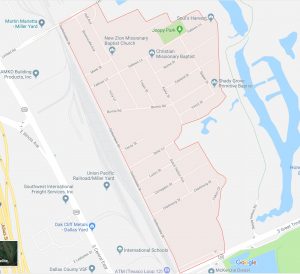
Joppa is already surrounded on three sides by heavy industry
First, they found significantly higher levels of ambient PM pollution in Joppa than was recorded by the only official EPA PM monitor in Dallas, located near Stemmons Freeway during the same time period, and higher than the levels the Committee found at various DART bus stops and routes they’ve also been monitoring as part of the new Green Streets bus electrification campaign
Levels in Joppa were as much as 30 to 50 % higher than the EPA monitor – even on a Sunday. Residents there are already breathing more PM pollution than residents in other parts of the city.
Secondly, if the Committee’s results were extrapolated over the course of a full year, these daily levels would add up to a violation of the EPA’s annual PM pollution standard. That is, if our findings are indicative of daily exposure, Joppa could already be exceeding the EPA standard and any additional PM pollution would only make matters worse.
You can read the entire short report on Joppa, Round one, prepared by Dr. Tate Barrett, our PM Science Director here: Joppa Report #1

Shannon Gribble and Cresanda Allen on a monitoring run in Joppa
Because there’s been no monitoring in Joppa until now, it’s possible the area has been in routine “non-attainment”of the EPA PM standard. It takes three years of annual averages above the standard, recorded at an officially designated EPA monitor, to classify an area as non-attainment and qualify for new federal new controls. However, Dallas’ only official EPA PM monitor is nine miles north of Joppa near Stemmons Freeway and Mockingbird.
Study after study has shown how People of Color generally, and African-Americans specifically, are disproportionately exposed to, and harmed by, PM pollution. While Dallas’ one and only EPA-designated PM monitor could be accurately recording PM levels north of the Trinity River, it’s not reflecting the reality of residents in Joppa, West Dallas, Cadillac Heights, or Cedar Crest.
There’s been a lot of discussion recently concerning inequity of resources in Dallas. It’s not news that this inequity extends even to the very air residents breathe and how the current regulatory system ignores those differences. But our Joppa monitoring casts a new spotlight on that fact. No equal protection is possible unless you have equal access to official monitors which determine enforcement of the laws.
That’s why when we turned our first results over to District 7 Council Member Kevin Felder on Friday, we recommended the City either consider moving Dallas’s sole EPA-designated PM monitor to Joppa, or pay for a second EPA-designated PM monitor to be located in Joppa, to begin recording data as soon as possible to determine if the area is indeed violating the EPA PM standard year-round.
These Joppa results also become another compelling example of why DFW needs its own local air quality monitoring network. It’s ridiculous that there’s only one PM monitor for all of Dallas County’s 2. 5 million residents stretched out over 900 square miles. PM levels as low as 5 ppb
Downwinders has joined with local universities and governments in pursuing the establishment of a local air quality monitoring network that could place inexpensive year-round PM monitors throughout Dallas and North Texas with real time information accessible to the public by a simple phone app. Dallas County Commissioner Theresa Daniels is expected to sponsor a resolution for the creation of such a network at the Commissioners Court in the coming weeks.
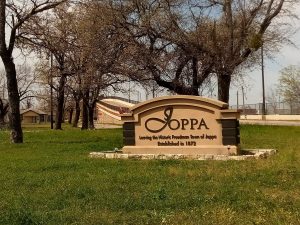 Dallas should follow. The City’s Office of Environmental Quality approves or disapproves of zoning changes like the ones being sought by the batch plants in Joppa without knowing what environmental burdens residents are already carrying. Even though they have the ability and capacity to do real time monitoring of neighborhoods where new industry wants to expand or locate, the OEQ never does. Nor does it have a single toxicologist or public health expert on its staff who’d want to see that kind of information before passing judgement on a zoning request. Instead it’s headed up by a lawyer and is mostly concerned about not making any definitive statements about local environmental health problems or environmental justice issues at all. With all the house-cleaning at Dallas City Hall since a new city manager took control, the OEQ now looks to be one of the last repositories for Business As Usual thinking. That must change.
Dallas should follow. The City’s Office of Environmental Quality approves or disapproves of zoning changes like the ones being sought by the batch plants in Joppa without knowing what environmental burdens residents are already carrying. Even though they have the ability and capacity to do real time monitoring of neighborhoods where new industry wants to expand or locate, the OEQ never does. Nor does it have a single toxicologist or public health expert on its staff who’d want to see that kind of information before passing judgement on a zoning request. Instead it’s headed up by a lawyer and is mostly concerned about not making any definitive statements about local environmental health problems or environmental justice issues at all. With all the house-cleaning at Dallas City Hall since a new city manager took control, the OEQ now looks to be one of the last repositories for Business As Usual thinking. That must change.
Downwinders PM Committee was back out in Joppa this last weekend for more rounds of air monitoring. Those results will be dowloaded and analyzed by Dr. Barrett and presented to the City Council on Wednesday by PM Committee member Misti O’Quinn. Stay tuned.
New Study Links PM Pollution to Depression and Suicide
Reviewing a decade of death statistics revealed a 16% increase in mortality risk on the first day of haze and a 27% increase on the second day compared to better air days.
If the haze was accompanied by high ozone pollution, the risk of death increased by 79%.
As shocking as this sounds, it aligns with other recent studies that have found a connection between short-term increases in air pollution and aberrant mental behavior. Significantly higher rates of Autism, Parkinson’s, ADHD and juvenile delinquency have all been linked to PM pollution, most at ambient levels assumed by regulators to be “safe.”
PM pollution has even been linked to low stock market performance in more than one study.
Researchers believe air pollution affects a person’s emotional state, making them more likely to feel depressed. They urge mental health professionals to be aware that bad air days are triggers for acute episodes.
PM pollution is so microscopically tiny it not only goes deep into your lungs, it actually can pass through your lung lining directly into your blood stream. Think about the places where your body uses a lot of blood – your heart and your brain. We’ve known PM causes heart attacks and strikes for some time. But research linking it to a wide variety of brain disorders is only fairly recent.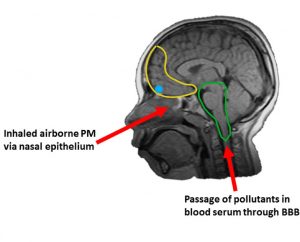
Authored by faculty at Hong Kong Polytechnic University, this most recent study examined more than 284,000 deaths, including those among people with mental and behavioral disorders including depression, bipolar, schizophrenia and dementia. It defined “haze days” as those on which pollutants gather in the air and cut visibility, usually dry days with low winds. In the study period from 2007 to 2014, there were 111 haze days when particle pollution was on average twice as high.
These findings are compatible with a recent Belgian study, which reported “[Short-term] increases in outdoor air pollutants such as particles or ozone can trigger suicide, particularly during warm periods, even at concentrations below the European thresholds.”
Unfortunately, we may have a local way to further prove this hypothesis. On October 19th of last year there was a still unexplained catastrophic air event that caused PM levels to go much more than twice a high as “normal,” accompanied by an increase in ozone pollution so severe it bumped the entire regional average by a part per billion. Could an examination of death certificates in Ellis, Dallas, Tarrant and Denton Counties reveal if this really “bad air day” caused a spike in North Texas suicides?
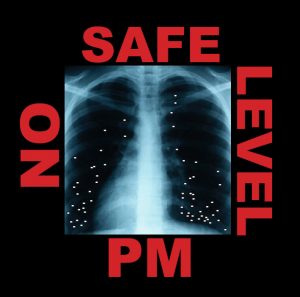
Downwinders at Risk’s “No Safe Level” PM Pollution Campaign Committee has scheduled its next meeting for Saturday March 10th at the Meadows Center at 2900 Live Oak.
Incompetence or Negligence? It Doesn’t Matter: Local Air Pollution Catastrophes on Oct 19th & Dec 11th Show Why DFW Must Have Its Own 21st Century Independent Air Quality Monitoring Network
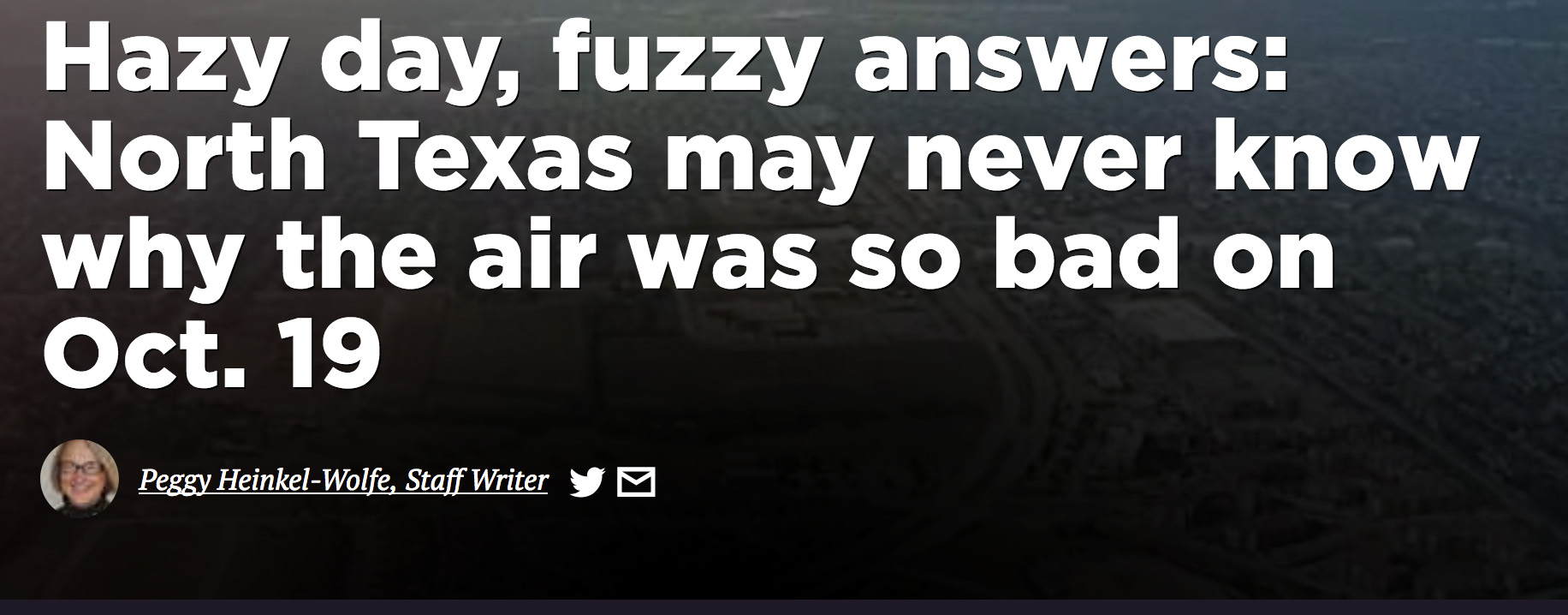
Q: What caused PM and Ozone pollution to spike so high and fast on Oct 19th that health alerts had to be issued from Dallas to Denton?
A: The Texas Commission on Environmental Quality couldn’t care less.
That’s the take-away from Peggy Heinkel-Wolfe’s story that appeared over the weekend in the Denton Record Chronicle.
You may remember we reported on the mystery shortly after it happened and tracked down all the local and non-local suspects cited by officials in the media that day. None of them turned out to be the cause of an air pollution incident that was so potent it raised the entire regional ozone average a whole part per billion and forced PM levels into the triple digits.
Heinkel-Wolfe goes one step further and makes inquires from the TCEQ itself. And the run around she gets is Catch-22 material.
TCEQ says they can’t investigate an air pollution problem unless there’s a known cause. But if there’s a known cause, what you’ve got there really isn’t an investigation any more, it’s an enforcement action, isn’t it?
This article may be the single most compelling case for why DFW needs its own locally-controlled air quality monitoring network. Find it here.
Q: Where are the results of the air samples the Dallas Fire Department supposedly took when a West Dallas Recycling was sending large plumes of black smoke over the surrounding and downwind neighborhoods on December 11th?
A: Nobody seems to know.
A huge pile of metal scrap burned and smoldered for over 24 hours at Sunshine Recycling on Ruder Street in West Dallas on December 11th. Thick plumes of smoke streaked the sky for half a day and into the night.
According to WFAA-TV, a Fire Department Hazardous Materials response team was on site because there were hazardous materials on site – although exactly what those were, or are, remain nameless.
That evening the Dallas City Councilman who represents West Dallas, Omar Narvaez, posted on his FaceBook page that “The Fire Dept has conducted testing and there is no hazardous materials burning.”
Really? Because when a scrap yard like that catches fire, you can bet there’s “hazardous materials” burning whether it’s officially noted or not. Plastic tubing and hoses become Dioxin-generating embers. Used oil has all kinds of metals in it that attach themselves to the smoke particles. Vinyl can generate very toxic fumes. Just the PM pollution from the smoke alone was enough to trigger all kinds of harmful health impacts. Very likely the entire pile of metal waste that was burning that night was indeed “hazardous.”
But OK, you say you took tests and they showed nothing out of the ordinary? Let’s see them. In December Downwinders submitted a Texas Open Records Act request to the City of Dallas for the results of those tests. We’re still waiting. As of today, and despite three phone calls to the Open Records Division of the City Secretary’s office, we still don’t have what it’s supposed to take no more than 10 business days to get. It’s been a month and counting. We’re trying to get some legal help to extract the information. Stay tuned.
For $500 a piece, we can install a dense grid of PM monitors across the region, tie them all together and present the information to the public in a transparent accessible way. It can be locally-controlled, directed by scientists, and independent of political influence.
It would automatically track plumes in real time, not an hour ago. It would give you reliable and specific levels of pollution rather than vague reassurances. It would transfer the power from officialdom to citizenry.
That’s the new Network we’re building. Stay tuned.


